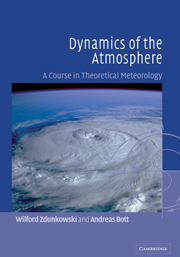Book contents
- Frontmatter
- Contents
- Preface
- Part 1 Mathematical tools
- Part 2 Dynamics of the atmosphere
- 1 The laws of atmospheric motion
- 2 Scale analysis
- 3 The material and the local description of flow
- 4 Atmospheric flow fields
- 5 The Navier–Stokes stress tensor
- 6 The Helmholtz theorem
- 7 Kinematics of two-dimensional flow
- 8 Natural coordinates
- 9 Boundary surfaces and boundary conditions
- 10 Circulation and vorticity theorems
- 11 Turbulent systems
- 12 An excursion into spectral turbulence theory
- 13 The atmospheric boundary layer
- 14 Wave motion in the atmosphere
- 15 The barotropic model
- 16 Rossby waves
- 17 Inertial and dynamic stability
- 18 The equation of motion in general coordinate systems
- 19 The geographical coordinate system
- 20 The stereographic coordinate system
- 21 Orography-following coordinate systems
- 22 The stereographic system with a generalized vertical coordinate
- 23 A quasi-geostrophic baroclinic model
- 24 A two-level prognostic model, baroclinic instability
- 25 An excursion concerning numerical procedures
- 26 Modeling of atmospheric flow by spectral techniques
- 27 Predictability
- Answers to Problems
- List of frequently used symbols
- References and bibliography
- Index
23 - A quasi-geostrophic baroclinic model
Published online by Cambridge University Press: 05 June 2012
- Frontmatter
- Contents
- Preface
- Part 1 Mathematical tools
- Part 2 Dynamics of the atmosphere
- 1 The laws of atmospheric motion
- 2 Scale analysis
- 3 The material and the local description of flow
- 4 Atmospheric flow fields
- 5 The Navier–Stokes stress tensor
- 6 The Helmholtz theorem
- 7 Kinematics of two-dimensional flow
- 8 Natural coordinates
- 9 Boundary surfaces and boundary conditions
- 10 Circulation and vorticity theorems
- 11 Turbulent systems
- 12 An excursion into spectral turbulence theory
- 13 The atmospheric boundary layer
- 14 Wave motion in the atmosphere
- 15 The barotropic model
- 16 Rossby waves
- 17 Inertial and dynamic stability
- 18 The equation of motion in general coordinate systems
- 19 The geographical coordinate system
- 20 The stereographic coordinate system
- 21 Orography-following coordinate systems
- 22 The stereographic system with a generalized vertical coordinate
- 23 A quasi-geostrophic baroclinic model
- 24 A two-level prognostic model, baroclinic instability
- 25 An excursion concerning numerical procedures
- 26 Modeling of atmospheric flow by spectral techniques
- 27 Predictability
- Answers to Problems
- List of frequently used symbols
- References and bibliography
- Index
Summary
Introduction
So far we have treated the so-called primitive equations of baroclinic systems which, in addition to typical meteorological effects, automatically include horizontally propagating sound waves as well as external and internal gravity waves. These waves produce high-frequency oscillations in the numerical solutions of the baroclinic systems, which are of no interest to the meteorologist. Thus, the tendencies of the various field variables are representative only of small time intervals of the order of minutes while the predicted weather tendencies should be representative of much longer time intervals.
In order to obtain meteorologically significant tendencies we are going to eliminate the meteorological noise from the primitive equations b y modifying the predictive system so that a longer time step in the numerical solution becomes possible. We recall that the vertically propagating sound waves are no longer a part of the solution since they are removed by the hydrostatic approximation. The noise filtering is accomplished by a diagnostic coupling of the horizontal wind field and the mass field while in reality at a given time these fields are independent of each other. The simplest coupling of the wind and mass field is the geostrophic wind relation. The mathematical systems resulting from the artificial inclusion of filter conditions are called quasi-geostrophic systems or, more generally, filtered systems. For such systems at the initial time t0 = 0 only one variable, usually the geopotential, is specified without any restriction.
- Type
- Chapter
- Information
- Dynamics of the AtmosphereA Course in Theoretical Meteorology, pp. 591 - 618Publisher: Cambridge University PressPrint publication year: 2003



